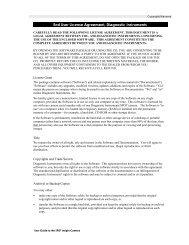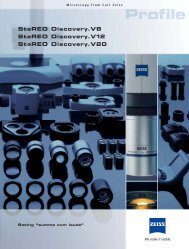optical interference filters - SPOT Imaging Solutions
optical interference filters - SPOT Imaging Solutions
optical interference filters - SPOT Imaging Solutions
You also want an ePaper? Increase the reach of your titles
YUMPU automatically turns print PDFs into web optimized ePapers that Google loves.
With Optical Monitoring, the intensity of a single color of<br />
light passing through the substrate is continually monitored.<br />
As the thickness of a layer increases, the transmission of the<br />
substrate will change predictably. Even with many tens of layers,<br />
the transmission and reflection off a thin film stack is predictable<br />
and easily calculable with the benefit of a computer. While we<br />
usually <strong>optical</strong>ly monitor using transmitted light, it is also possible<br />
to <strong>optical</strong>ly monitor with reflected light<br />
Several of our deposition chambers have been outfitted for automated<br />
manufacturing. The use of a custom written application<br />
in “LabView” tells us when to precisely cut layers at the optimal<br />
thickness; using <strong>optical</strong> monitoring of real-time signal.<br />
For optimization of transmission and reflection regions, we employ<br />
a number of proprietary commercial packages. These tools<br />
allow for the best compromise in performance at all wavelengths<br />
in question.<br />
The Quarter-Wave Stack Reflector is a basic building block<br />
of <strong>optical</strong> thin-film products. It is composed of alternating layers of<br />
two dielectric materials in which each layer has an <strong>optical</strong> thickness<br />
corresponding to one-quarter of the principal wavelength. This<br />
coating has the highest reflection at the principal wavelength, and<br />
transmits at wavelengths both higher and lower than the principal<br />
wavelength. At the principal wavelength, constructive <strong>interference</strong><br />
of the multiple reflected rays maximizes the overall reflection of<br />
the coating; destructive <strong>interference</strong> among the transmitted rays<br />
minimizes the overall transmission.<br />
Figure 1 illustrates the spectral performance of a quarter-wave<br />
stack reflector. Designed for maximum reflection of 550nm light<br />
waves, each layer has an <strong>optical</strong> thickness corresponding to one<br />
quarter of 550nm. This coating is useful for two types of <strong>filters</strong>:<br />
edge <strong>filters</strong> and rejection band <strong>filters</strong>.<br />
% Transmission<br />
100<br />
50<br />
0<br />
400 500 600 700 800 900<br />
Wavelength (nm)<br />
Figure 1<br />
Quarter-Wave Stack<br />
Reflector<br />
The Fabry-Perot Interferometer, or a single-cavity coating, is formed<br />
by separating two thin-film reflectors with a thin-film spacer.<br />
In an all-dielectric cavity, the thin-film reflectors are quarter-wave<br />
stack reflectors made of dielectric materials.<br />
% Transmission<br />
100<br />
90<br />
80<br />
70<br />
60<br />
50<br />
40<br />
30<br />
20<br />
10<br />
0<br />
825 830 835 840 845 850 855<br />
Figure 2 Single-Cavity Coating<br />
Wavelength (nm)<br />
The spacer, which is a single layer of dielectric material having an<br />
<strong>optical</strong> thickness corresponding to an integral-half of the principal<br />
wavelength, induces transmission rather than reflection at the principal<br />
wavelength. Light with wavelengths longer or shorter than the<br />
principal wavelength will undergo a phase condition that maximizes<br />
reflectivity and minimizes transmission. The result is a passband<br />
filter. The size of the passband region, the degree of transmission<br />
in that region, and the degree of reflection outside that region is<br />
determined by the number and arrangement of layers. A narrow<br />
passband region is created by increasing the reflection of the quarter-wave<br />
stacks as well as increasing the thickness of the thin-film<br />
spacer. In a metal-dielectric-metal (MDM) cavity, the reflectors of<br />
the solid Fabry-Perot interferometer are thin-films of metal and the<br />
spacer is a layer of dielectric material with an integral half-wave<br />
thickness. These are commonly used to filter UV light that would<br />
be absorbed by all-dielectric coatings.<br />
The Multi-Cavity Passband Coating is made by coupling two<br />
or more single-cavities with a matching layer. The transmission at<br />
any given wavelength in and near the band is roughly the product<br />
of the transmission of the individual cavities. Therefore, as the<br />
number of cavities increases, the cut-off edges become steeper<br />
and the degree of reflection becomes greater.<br />
When this type of coating is made of all-dielectric materials, out-ofband<br />
reflection characteristically ranges from about (.8 x CWL) to<br />
(1.2 x CWL). If thin films of metal, such as silver, are substituted for<br />
some of the dielectric layers, the metal’s reflection and absorption<br />
properties extend the range of attenuation far into the IR. These<br />
properties cause loss in the transmission efficiency of the band.<br />
As mentioned previously, the choice of materials to be used in a<br />
multilayer design is very wide, ranging from metals to the oxides<br />
of metals, to the salts and more complex compounds, to the<br />
small molecule organics. General features required to be practical<br />
include environmental stability, stress, deposition, temperature,<br />
transparency, etc. Most of the industry limits the selection to refrac-<br />
For current product listings, specifications, and pricing:<br />
www.omega<strong>filters</strong>.com • sales@omega<strong>filters</strong>.com<br />
1.866.488.1064 (toll free within USA only) • +1.802.254.2690 (outside USA)<br />
23

















